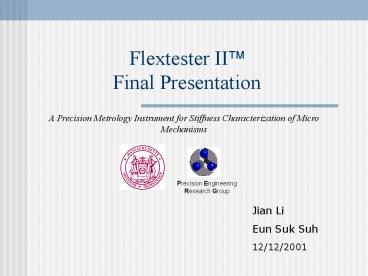Flextester II Final Presentation PowerPoint PPT Presentation
1 / 19
Title: Flextester II Final Presentation
1
Flextester II?Final Presentation
A Precision Metrology Instrument for Stiffness
Characterization of Micro Mechanisms
Precision Engineering Research Group
Jian Li Eun Suk Suh
12/12/2001
2
Contents
- Introduction
- Functional Requirements
- Theory of Operation
- Mechanical Design Overview
- Calibration And Measurement
- Experimental Data From Flextester II?
- Conclusion and Future Works
3
Introduction
Background for Development
In Need of a Machine which can accurately measure
the F - d of small MEMS micro structure, as shown
4
Introduction
Background for Development
The objective of this project is to improve upon
the original Flextester?, which was built for
2.75-1999 (Shown in the Picture)
5
Functional Requirements
6
Theory Of Operation
d1 - d3
d1 d3
Optical Sensor
Optical Sensors
Reference Flexure
d1
MEMS Beam (represented by a spring)
Force
d1 - d2
7
Improved Design of the F-II
Main Body (More compact and accurate flexures)
Linear Stages
Probe Head (X and Z force measurement)
Vacuum Chuck
Micrometer
8
Improved Design of the F-II
Main Body
Probe Head
Linear Stages
Micrometer
Vacuum Chuck
9
Mechanical Design Overview
- Main Body Specification
- - Wn 110 Hz
- - Crab leg flexures for
- non-parasitic motion
- - Optimized flexure layout
- for decoupled X-Z motion
- - Optimized flexure dimension
- - KC probe interface with
- magnetic preload
Coupling Interface
Crab Leg Flexures
10
Mechanical Design Overview
- 2. Probe Head Specification
- - Wn 55 65 Hz
- - KC for repeatable mtg.
- - Parasitic free X-Z F-d
- measurement
- - Sensors in differential
- configuration mounting
- for better noise rejection
Sensors
Magnet
KC
Reference Flexure
Needle
11
Mechanical Design Overview
3. Main Assembly - Probe head and main
body are held together by magnet at the
coupling interface - Probe tip moves
with straightness error 0.6
Micrometer
Magnet
Probe Tip
12
Calibration And Measurement
- Principle Procedure
- - Optical Barcode Sensors are used.
- - By creating calibration look-up tables of
voltage vs. displacement, very accurate
displacement measurements can be achieved.
Vo
13
Calibration And Measurement
Create a first look-up table
V2
V3
Displacement (micrometer reading)
Voltage V1
X X X X . . .
Y Y Y Y . . .
V1
Reference flexure
14
Calibration And Measurement
Create a second look-up table
V2
V3
Displacement (micrometer reading)
Voltage V1
Voltage V2-V3
Z Z Z Z . . .
X X X X . . .
Y Y Y Y . . .
V1
Tip locked
15
Calibration And Measurement
V2
Add force calibration data to the look up table
V1
Precision Force Gauge (represented by a spring)
16
Experimental Data
2. Calibration Data
In-plane calibration
Out-of plane calibration
17
Experimental Data
3. MEMS Bi-stable Beam Ideal F-d Curve
18
Experimental Data
4. Experimental Results
FEA Result
Experimental Result
19
Conclusion
- Flextester-II? can measure F-d in and out of
plane with the same probe head. - Improved, smaller probe head assembly with
differential sensor configuration for signal
noise reduction (CNR) - Incorporation of KC magnet for easily
exchangeable probe head assembly. - Overall smaller design than original Flextester?
- Incorporation of a vacuum chuck for holding
silicon wafers.

